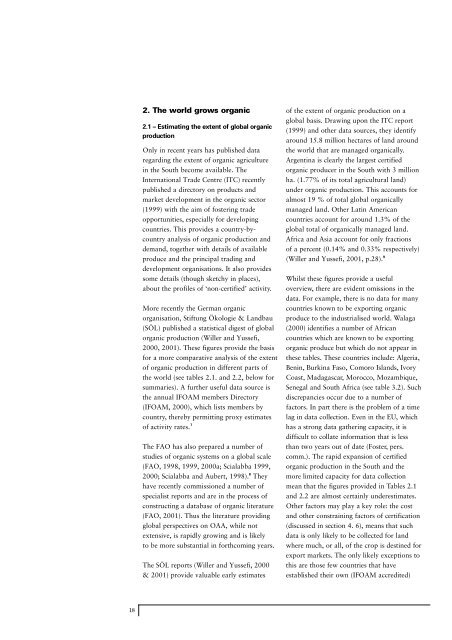The Real Green Revolution - Greenpeace UK
The Real Green Revolution - Greenpeace UK
The Real Green Revolution - Greenpeace UK
Create successful ePaper yourself
Turn your PDF publications into a flip-book with our unique Google optimized e-Paper software.
2. <strong>The</strong> world grows organic<br />
2.1 – Estimating the extent of global organic<br />
production<br />
Only in recent years has published data<br />
regarding the extent of organic agriculture<br />
in the South become available. <strong>The</strong><br />
International Trade Centre (ITC) recently<br />
published a directory on products and<br />
market development in the organic sector<br />
(1999) with the aim of fostering trade<br />
opportunities, especially for developing<br />
countries. This provides a country-bycountry<br />
analysis of organic production and<br />
demand, together with details of available<br />
produce and the principal trading and<br />
development organisations. It also provides<br />
some details (though sketchy in places),<br />
about the profiles of ‘non-certified’ activity.<br />
More recently the German organic<br />
organisation, Stiftung Ökologie & Landbau<br />
(SÖL) published a statistical digest of global<br />
organic production (Willer and Yussefi,<br />
2000, 2001). <strong>The</strong>se figures provide the basis<br />
for a more comparative analysis of the extent<br />
of organic production in different parts of<br />
the world (see tables 2.1. and 2.2, below for<br />
summaries). A further useful data source is<br />
the annual IFOAM members Directory<br />
(IFOAM, 2000), which lists members by<br />
country, thereby permitting proxy estimates<br />
of activity rates. 7<br />
<strong>The</strong> FAO has also prepared a number of<br />
studies of organic systems on a global scale<br />
(FAO, 1998, 1999, 2000a; Scialabba 1999,<br />
2000; Scialabba and Aubert, 1998). 8 <strong>The</strong>y<br />
have recently commissioned a number of<br />
specialist reports and are in the process of<br />
constructing a database of organic literature<br />
(FAO, 2001). Thus the literature providing<br />
global perspectives on OAA, while not<br />
extensive, is rapidly growing and is likely<br />
to be more substantial in forthcoming years.<br />
<strong>The</strong> SÖL reports (Willer and Yussefi, 2000<br />
& 2001) provide valuable early estimates<br />
of the extent of organic production on a<br />
global basis. Drawing upon the ITC report<br />
(1999) and other data sources, they identify<br />
around 15.8 million hectares of land around<br />
the world that are managed organically.<br />
Argentina is clearly the largest certified<br />
organic producer in the South with 3 million<br />
ha. (1.77% of its total agricultural land)<br />
under organic production. This accounts for<br />
almost 19 % of total global organically<br />
managed land. Other Latin American<br />
countries account for around 1.3% of the<br />
global total of organically managed land.<br />
Africa and Asia account for only fractions<br />
of a percent (0.14% and 0.33% respectively)<br />
(Willer and Yussefi, 2001, p.28). 9<br />
Whilst these figures provide a useful<br />
o v e rv i e w, there are evident omissions in the<br />
data. For example, there is no data for many<br />
countries known to be exporting org a n i c<br />
p roduce to the industrialised world. Wa l a g a<br />
(2000) identifies a number of African<br />
countries which are known to be export i n g<br />
o rganic produce but which do not appear in<br />
these tables. <strong>The</strong>se countries include: Algeria,<br />
Benin, Burkina Faso, Comoro Islands, Ivory<br />
Coast, Madagascar, Morocco, Mozambique,<br />
Senegal and South Africa (see table 3.2). Such<br />
d i s c repancies occur due to a number of<br />
factors. In part there is the problem of a time<br />
lag in data collection. Even in the EU, which<br />
has a strong data gathering capacity, it is<br />
d i fficult to collate information that is less<br />
than two years out of date (Foster, pers.<br />
comm.). <strong>The</strong> rapid expansion of cert i f i e d<br />
o rganic production in the South and the<br />
m o re limited capacity for data collection<br />
mean that the figures provided in Tables 2.1<br />
and 2.2 are almost certainly undere s t i m a t e s .<br />
Other factors may play a key role: the cost<br />
and other constraining factors of cert i f i c a t i o n<br />
(discussed in section 4. 6), means that such<br />
data is only likely to be collected for land<br />
w h e re much, or all, of the crop is destined for<br />
e x p o rt markets. <strong>The</strong> only likely exceptions to<br />
this are those few countries that have<br />
established their own (IFOAM accre d i t e d )<br />
18




![[2007] EWHC 311 - Greenpeace UK](https://img.yumpu.com/22079793/1/184x260/2007-ewhc-311-greenpeace-uk.jpg?quality=85)












